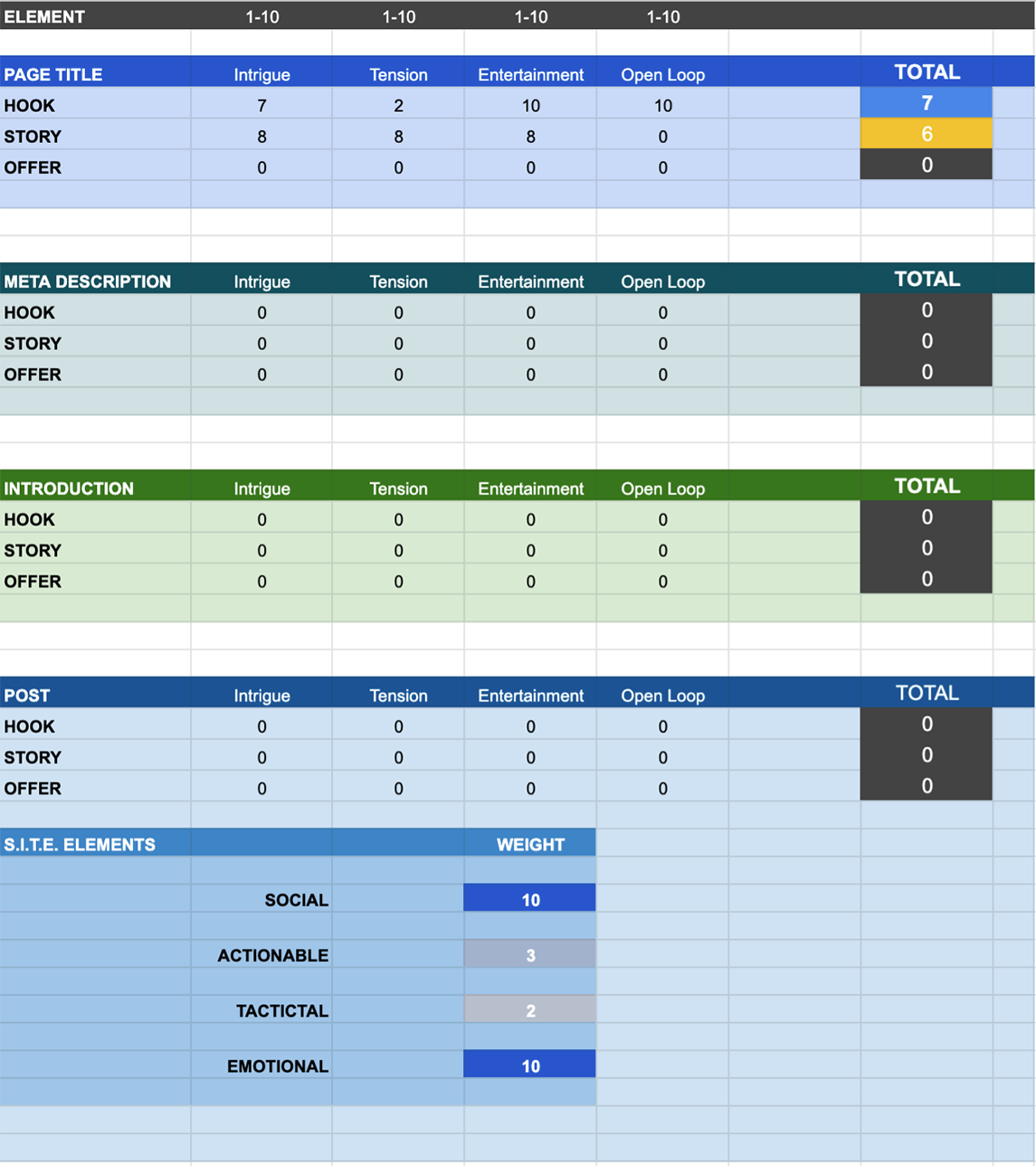What if there was a secret ingredient that would make all your blog posts go viral?
Four million blog posts are published every single day.
Every. Single. Day.
It’s understandable why your blog posts aren’t going viral. Unless you’re writing something that raises your content above the noise, your post is just a single blip in four million pieces of content.
So, what can you do?
First, you have to grab the readers attention. Then, you have to keep it.
If you can accomplish those two tasks, you’ve basically won the game. And, it’s not that difficult, either. If you master the 3-stage framework of the Hook, the Story, and the Offer, you will find a much higher engagement rate with your content. And, high engagement is the secret ingredient to blog posts that go viral.
So, how do you get it?
website grader
Diagnose Your Growth Blockers & Unlock Your Brand’s Potential
Enter your website URL and get a tailored marketing roadmap that reveals untapped opportunities to boost traffic, eliminate roadblocks, and fuel sustainable growth.
- Identify growth roadblocks on your website
- Pinpoint opportunities you can leverage to grow your brand
- Boost traffic with personalized strategies
Thanks for submitting the form!
Making Your Blog Posts Go Viral
In one of his books, I forget which, Jay Baer spoke of the nature of attention. Getting attention is as easy as disruption.
Keeping attention is actually the hard part.
In his book, Baer mentioned what it would be like if you’re sitting in a coffee shop typing away on your laptop. Suddenly, three clowns walk into the cafe.
Bang: they have your attention.
Getting Attention

Their bright clothes, makeup, big shoes… for those who don’t suffer from coulrophobia, you will take the time to notice them.
These clowns get coffee, and sit quietly at a table chatting. After a few short seconds, you go back to your work. A few hours later, you realize at some point the clowns left, and you never noticed them again.
The point?
The clowns got your attention because they disrupted the normal. But, they didn’t keep the attention, because the shock quickly wore off.
Disruption captures attention, but it doesn’t keep it.
Keeping Attention
Now, imagine the clowns walked in, then started juggling and performing magic tricks. After a 30-minute dazzling performance, they leave the cafe. You look back down at your laptop and realize you haven’t done a single bit of work since they showed up.
But, you eventually forget about the clowns, and go back to your normal life.
Leveraging Attention
Now, imagine the clowns performed for thirty minutes, completely dazzling the crowd. At the end of the performance, they announce they have a trick that awes even the most cynical crowd. They ask if the cafe wants to see that trick.
Of course, everyone does!
Well, they then hand out some flyers to their evening show at the local theatre.
That’s the call to action!
- They earned attention.
- They kept attention.
- And they leveraged attention.
If you want your blog posts to go viral, you have to achieve those three objectives. Luckily, there’s a framework for that.
The Hook, Story, Offer Framework
This framework isn’t rocket science. But, it will instantly upgrade your blog content, and give it a much higher chance of going viral.
It starts with a hook, something that grabs attention.
It continues with a story that builds engagement and earns emotional buy-in.
It finishes with an offer, something that leverages that attention into a desired action.
The Hook

If you’re writing a blog article, you’re solving some kind of problem. If you peel away enough layers of the onion, you’ll eventually arrive at a reason: why would someone take the time to read your article?
That’s the thing that will hook them, capturing their attention.
In this article, for example, the hook is the possibility that there’s a simple secret ingredient to viral blog posts. For someone that’s searching for “how to make your blog posts go viral,” that’s an enticing hook.
But, hooks don’t have to be promises or teases. They can be challenges.
What if I told you blogging was a waste of time?
That might have been a good hook for this article.
A great hook either promises something desirable, or it disrupts and captures your attention like a clown in a coffee shop. But, that’s only the beginning.
The Story

This is the performance that makes you want to attend the clown’s evening show. It immerses you and makes you want more.
When you get someone’s attention, nothing keeps that attention quite like telling a story.
For example, there was this one time I was writing a blog post. It wasn’t an overly complicated topic, but I was having such a hard time coming up with a story that would drive home the real purpose of the post.
I wrote maybe 15 drafts, throwing each of them in the trash.
I was frustrated, to say the least. With each failed attempt at a good story, I got more frustrated. I could feel my blood pressure rising, and every message on slack made me want to explode.
Finally, it all clicked!
And, I have your attention.
The key to the perfect story is one that will accomplish three things:
1. Be interesting to the reader, something they can identify with. (Notice how my story was about writing blog posts?)
2. Be relatable so it gets buy-in to the message.
3. Future-pace the call to action.
In the example above, it’s interesting because it’s hyper-relevant to the topic of the post, and by extension, the reader.
It’s relatable, because who hasn’t been frustrated when writing?
And, it future-paces my call to action, which you will see in a bit.
The Offer
What do you want the reader to do?
Every blog post needs an offer that pushes the reader down the road and onto success, for whatever mission the blog post is helping them accomplish.
This offer should never be self-serving, at least not in how it’s framed. It always needs to be wrapped in a presentation of giving the reader more of what they want.
If the story is great (think of the clown’s performance, plus the story of this amazing trick you didn’t get to see), your reader will want to convert on the offer.
Using the Framework
For every blog post, review it for the hook, the story, and the offer.
When you’re writing new blog posts, consider following that flow. Write a great hook, tell a great story, and make a great offer.
Simple!
Drilling Down With the Framework
Think of the entire blog post as being made of the Hook, Story, Offer framework. At a macro level, the whole post will check off those three boxes, in order.
But, if you drill down, you can use the framework to write better intros, and get better SEO as well.
Let’s take a look at SEO:
Your Title is the Hook Your Meta Description is the story The Content is the offer
When someone sees your page show up in SERPS, the Hook, Story, Offer framework will increase the Click-Through-Rates, which will help you in the rankings.
Let’s take a look at Blog Introductions
If your introduction is boring, no one will read the blog post. While on a macro level, the introduction should be communicating the hook. But, on a micro level, the introduction as a complete unit should also feature the framework.
Your first sentence or paragraph needs to be a hook. The next paragraph needs to introduce a story. And the final piece needs to make the offer, which of course is to read the article.
A Hook, Story, Offer Template

If you want your blog posts to go viral, incorporating the Hook, Story, Offer framework in every post, macro and micro, will make the post more engaging, and more likely to go viral.
But, doing it is a lot harder than talking about it.
That’s why we created a grading sheet to help us incorporate the framework easily. And, it helps us to understand when we’re doing it well, and when we need to work on improving the article.
The 4 Levels of Effectiveness
When measuring the quality of your hook, it should be measured on its ability to drive intrigue, increase tension, entertain, or open brain loops.
In the grading worksheet, we grade each element on these four fronts:
Intrigue: Does it intrigue me? Tension: Does it raise the stakes? Entertainment: Is it not going to be boring? Open Loop: Does it have the effect of the cliffhanger like “24” or “Lost?”
Step 1: Grading the Page Title
It’s a little hard to implement the Hook, Story, Offer framework into a single sentence. But, if you do, that sentence rocks!
While a page title doesn’t give you an opportunity to tell a story, if done right, it can present an entire story without telling any details.
The title of this post, for example, tells a story of our posts going viral.
VIDEO TRAINING
Get The Growth Marketing Playbook.
Learn to plan, budget, and accelerate growth with our exclusive video series. You’ll discover:
- The 5 phases of profitable growth
- 12 core assets all high-growth companies have
- Difference between mediocre marketing and meteoric campaigns
Thanks for submitting the form!
Step 2: Grading the Meta Description
The meta description isn’t used directly in Google’s algorithm. So, stuffing keywords doesn’t help it rank. But, the meta description directly influences the desire of the searcher to click or not. A great meta description has a hook, introduces a story, and presents the offer of the content on the other side of the click.
Step 3: Grading the Introduction
In most blog listing pages, and on social shares, the blog introduction shows before the read-more tag. This is a critical piece of the content, probably the second-most important part of the post outside of the title.
The offer, of course, is the rest of the blog post.
Step 4: Grading the Post
Now, you put the grade to the entire post. Inside the Hook, Story, Offer framework, you can incorporate different elements to make them as impactful as possible.
There are four elements we strive to utilize: the social, the actionable, the tactical, and the emotional.
- Social: Stories that carry social proof.
- Actionable: Inspiring follow-through.
- Tactical: Practical how-to information.
- Emotional: Stories that increase the desire to act.
Your hook, for example, can include one or more of these elements. Your story may include one or more. And, so on.
For example, the story that I told as an example above was a story that involved both social and emotional. Not only was I telling a story writers can identify with, I was bringing out the feelings I felt during that story.
This entire post has implemented a tactical feeling, showing you how to do something.
The conclusion of this article is going to go very actionable, slapping you in the face with the need to act.
Putting It All Together
You can slog through blog writing all you want, and enjoy being one of the four million. Or, you can level up your blogging game.
The Hook, Story, Offer framework is not just a writing trick. It’s not just about information architecture. It is about creating content in the way humans like to engage.
We all like order. We like a good flow in what we’re reading, and we all want to be inspired to not only know how to solve a problem, but to get off our butts and actually solve the problem.
So, if you want your posts to rise above all the noise on the internet, you need to get really good at the Hook, Story, Offer framework. And, if you want to get good at it, you need to download the grading checklist right now.
Stop making excuses. Just, go download it. And then, use it on the next 20 blog posts you write. Before long, you’ll be Hook, Story, Offering every piece of content you create, from blog posts to social posts to podcasts to videos… it’s all the same.










